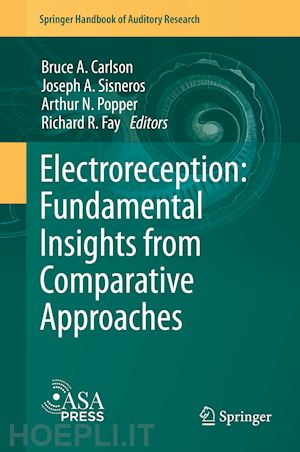
Questo prodotto usufruisce delle SPEDIZIONI GRATIS
selezionando l'opzione Corriere Veloce in fase di ordine.
Pagabile anche con Carta della cultura giovani e del merito, 18App Bonus Cultura e Carta del Docente
A fundamental goal of neuroscience is to understand how the nervous system extracts biologically relevant information from the natural environment and how it uses that information to guide and coordinate behavior necessary for reproduction and survival. The electrosensory systems of weakly electric teleost fishes and those of nonteleost fishes are attractive systems for addressing basic questions about neuronal information processing and its relationship to natural behavior. Comparative approaches in these fishes have led to the identification of fundamental mechanisms that have shaped the adaptive evolution of sensory systems across animal taxa. Understanding how sensory systems encode and integrate information about the natural world has far reaching implications for advancing our knowledge in the basic biomedical sciences and in understanding how the nervous system has evolved to control behavior.
The primary goal of this book is to provide a comparative perspective on the topic of electroreception and review some of the fundamental insights gained from studies of electrosensory and electromotor systems. Although totally independent, this book follows from volume 21 in the Springer Handbook of Auditory Research series, Electroreception (Bullock, T. H., Hopkins, C. D., Popper, A. N., and Fay, R. R., 2005, Springer-Verlag, New York).
1. The Evolution of Electroreception: An Historical Overview
Bruce A. Carlson and Joseph A. Sisneros
This chapter will provide an historical introduction to the field that focuses on evolutionary diversity. This will include a description of phylogenetic diversity that helps orient readers to the various taxonomic groups that have electroreception. It will also address phenotypic diversity, including differences between tuberous and ampullary electrosensory systems, and the wide variety of tuberous electrosensory systems, and how these differences are adapted to behavioral function.
2. Comparative Genomics Approaches to the Evolution and Development of Electroreceptors
Clare V. Baker
3. Comparative Genomics Approaches to the Evolution and Development of Electric Organs
Graciela A. Unguez, Jason R. Gallant, and Harold H. Zakon
4. Biophysical Basis of Electric Signal Diversity
Michael R. Markham
5. Evolutionary Drivers of Electric Signal Diversity
Rüdiger Krahe
This chapter will focus on ecological genetics and the ultimate evolutionary causes of EOD diversification in gymnotiforms and mormyroids, including ecological adaptation, sexual selection, and predation. In addition, this chapter will address the role of electric signaling in species diversification.
6. Sensory Adaptations to Active Sensing and Communication
Eric S. Fortune
7. Evolution of Time-Coding in Electrosensory and Auditory Systems
Bruce A. Carlson
8. Envelope Coding and Processing
Maurice J. Chacron
9. Spatial Learning and the Telencephalon
Leonard Maler
There have been exciting advances in understanding the neural bases of spatial learning and navigation in recent years, but much of this work is limited in its taxonomic scope. The focus of this chapter will be on recent advances in our understanding of spatial learning in gymnotiform fishes and its neural basis in the telencephalon. There will be a particular emphasis on how the electrosensory system of fishes can be used to identify fundamental aspects of spatial learning and its neural basis across vertebrates.
10. Sensorimotor Integration in the Processing of Reafferent Sensory Input
Nathaniel B. Sawtell
Decades of research on mormyrid electric fishes have provided tremendous insights into sensorimotor integration, filtering of reafferent and exafferent sensory input, and the generation and subtraction of sensory expectations. This chapter will focus on the most recent developments in this field, which have revealed the cellular, synaptic, and circuit bases for generating and subtracting sensory expectations, using a combination of computational and experimental studies. There will be a particular emphasis on links to auditory processing and behavior in mammals, and how research on these fishes has led to fundamental insights into the processing of reafferent sensory input.
11. Hormonal Influences on Social Behavior
Ana Silva
This chapter will address hormonal influences on social behavior through actions on sensory and motor systems. There will be a particular focus on diversity in social behavior, and how hormonal actions differ in species with divergent aggressive behavior.
12. Predatory Behavior of Strongly Electric Fish
Kenneth C. Catania
Bruce A. Carlson is Professor of Biology at Washington University in St. Louis.
Joseph A. Sisneros is Professor of Psychology at the University of Washington, Seattle
Arthur N. Popper is Professor Emeritus and research professor in the Department of Biology at the University of Maryland, College Park
Richard R. Fay is Distinguished Research Professor of Psychology at Loyola











Il sito utilizza cookie ed altri strumenti di tracciamento che raccolgono informazioni dal dispositivo dell’utente. Oltre ai cookie tecnici ed analitici aggregati, strettamente necessari per il funzionamento di questo sito web, previo consenso dell’utente possono essere installati cookie di profilazione e marketing e cookie dei social media. Cliccando su “Accetto tutti i cookie” saranno attivate tutte le categorie di cookie. Per accettare solo deterninate categorie di cookie, cliccare invece su “Impostazioni cookie”. Chiudendo il banner o continuando a navigare saranno installati solo cookie tecnici. Per maggiori dettagli, consultare la Cookie Policy.